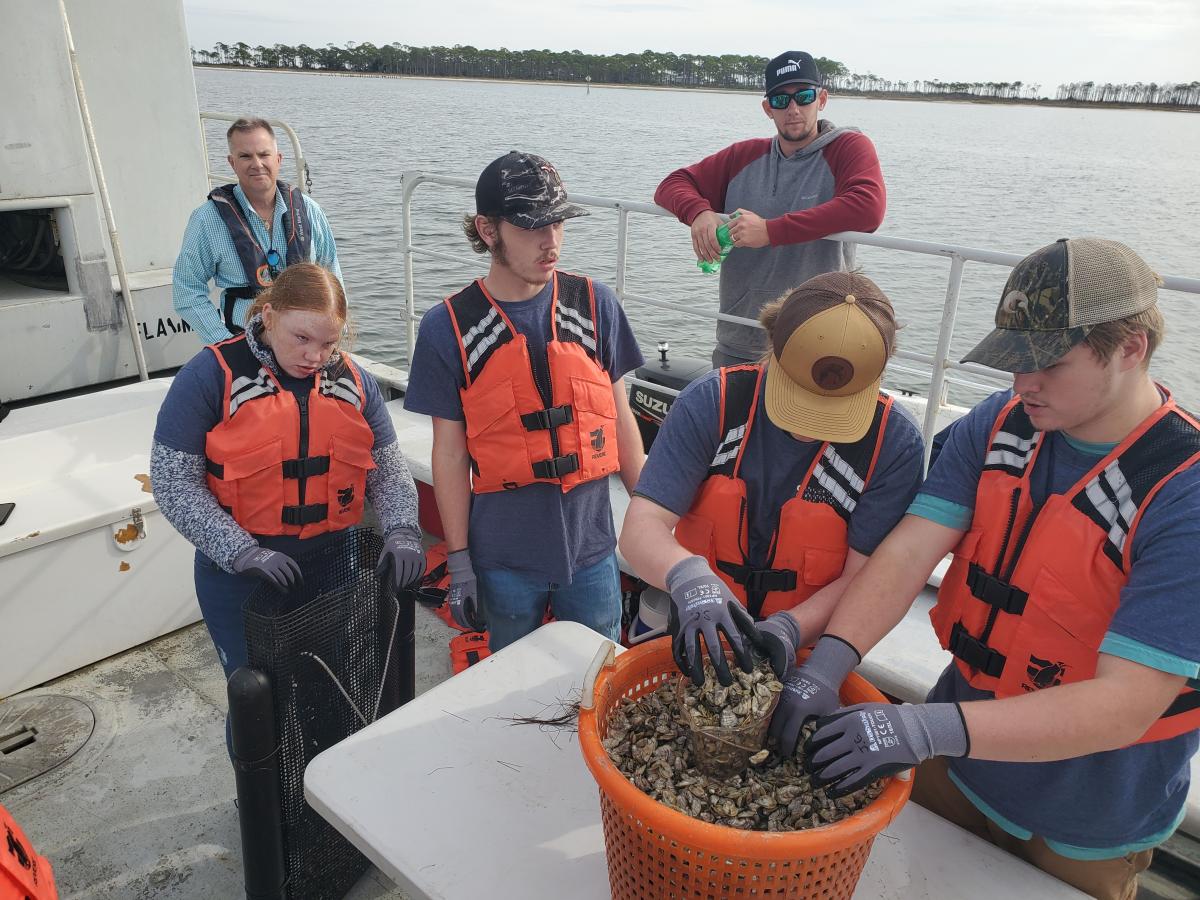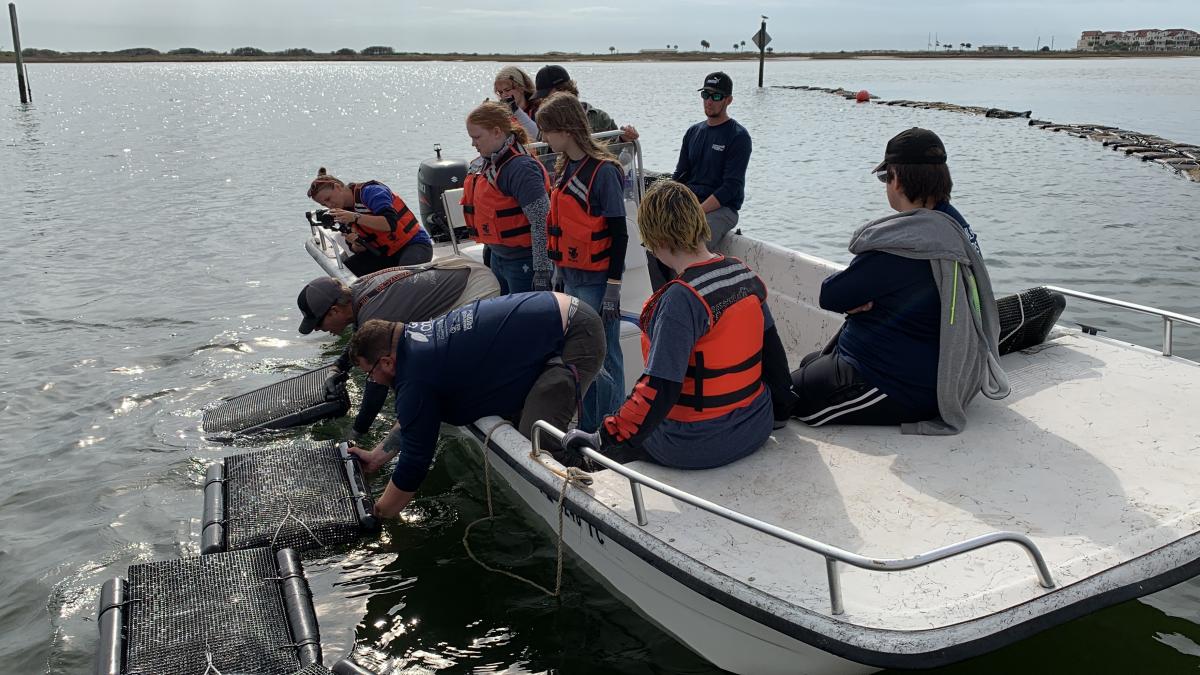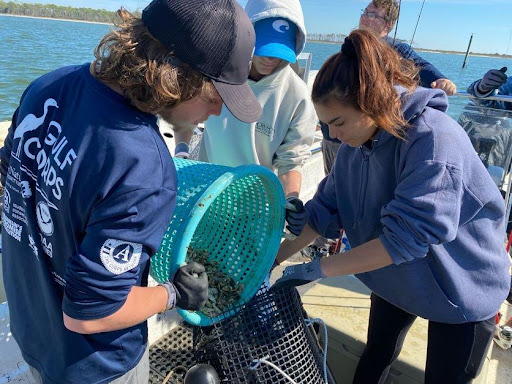Students Carry On an Important Cultural and Economic Touchstone Through Oyster Aquaculture

eeBLUE: Harvest Stories
This post was written by Dr. Marcy Cockrell, biological administrator at the Florida Department of Agriculture and Consumer Services Division of Aquaculture, and Anita Grove, Coastal Training Program Coordinator at the Apalachicola National Estuarine Research Reserve.
Project partners include the Conservation Corps of the Forgotten and Emerald Coasts-OysterCorps, Apalachicola National Estuarine Research Reserve, the Florida Department of Agriculture and Consumer Services (FDACS) Division of Aquaculture, Rattlesnake Cove Oyster Company, and the Florida State University Coastal and Marine Laboratory.

Students with the Conservation Corps of the Forgotten Coast are learning about oyster aquaculture first-hand this year through an exciting collaboration between the Corps, Rattlesnake Cove Oyster Company, the Apalachicola National Estuarine Research Reserve (ANERR), the Florida Department of Agriculture and Consumer Services (FDACS) Division of Aquaculture, and the Florida State University Coastal and Marine Laboratory. Students are working on an established commercial aquaculture lease in Apalachicola Bay—under the guidance of Rattlesnake Cove Oyster Company partners Jeff Wren and Todd Bracken—where they will plant, tend, and harvest oysters through one complete growout cycle, all while documenting the project, sharing their experiences with the community, learning about career opportunities, and learning about the cultural and environmental importance of oysters in their own backyard. This new educational and training experience for students is called OysterCorps.
Oysters were synonymous with Apalachicola for over 200 years. Recognized as some of the best oysters in the world, the crop was an economic mainstay of this rural coastal community with a rich maritime culture. Most families had a direct tie to the industry, whether it be harvesting oysters, processing them, or serving them in local restaurants. The people here are integrally linked to Apalachicola Bay and its rich resources. However, after several years of changing water conditions, the wild harvest oyster industry collapsed and was declared a fisheries disaster in 2012. Numerous efforts are being employed to bring back the natural oyster beds, and oyster aquaculture has helped sustain this region so well known for its oysters.
So far in the project, students have worked to start understanding what it takes to grow aquacultured oysters. In late October 2021, Todd Bracken and Jeff Wren instructed the students on how to build oyster cages. The cages are designed to hold the oysters while they are growing in the water on a commercial aquaculture lease. Over the course of a few sessions, students built 60 cages in total. The cages are constructed out of a strong plastic mesh folded into a rectangle and outfitted with floats.

Then, on December 8, seventeen students visited the commercial lease being used for the project for the first time aboard the Reserve’s research vessel the R.V. Tideline. Guided by Todd and Jeff, the students divided up 21,000 juvenile oysters among ten of the cages that they built. These cages were secured and then deployed by the students on the lease as partners from the FDACS Division of Aquaculture and Reserve looked on. The average size of the juvenile oysters at planting was 6–8mm (0.2–0.3 inches).
On January 27, 2022, students traveled back out to the lease to tend the oysters and “split” them into new cages; “splitting” reduces density in each growout bag so that the oysters have room to grow properly. Students transferred the oysters from 9mm diameter cages to 14mm diameter cages. The average size of the oysters had increased to 3.8cm (1.5 inches), with several observed at 5cm (2 inches)! While tending the lease students observed a diversity of other marine life: stone crabs, blue crabs, mud crabs, blennies, and grass shrimp were living in or around the oyster cages.

OysterCorps students will continue to tend the lease through the fall of 2022. They will document their progress and share what they learn with the community through presentations at community events, via social media, and through a student-produced video. Local high school students are planning a visit to the lease in April where OysterCorps students will share lessons learned with their peers. OysterCorps will also share outreach to the public on the project at Estuaries Day on May 6, a local festival in Apalachicola that celebrates the ecosystem, science, and culture surrounding Apalachicola Bay.
Since the eeBLUE project began, OysterCorps has been featured in local news media and just won a Project of the Year award from the Conservation Corps network! You can read more about their award here.
To keep up with the OysterCorps progress, check out the Friends of the Reserve Facebook Page and the Conservation Corps Facebook page.
-----------------
OysterCorps is a training academy based within Conservation Corps of the Forgotten and Emerald Coasts (CCFEC). The program seeks to restore oyster habitats, strengthen coastal resilience in the face of climate change, and drive economic diversification through aquaculture. OysterCorps participants are opportunity youth ages 17 through 25 (and veterans up to age 29) who reside in the Florida Panhandle. The program is supported by The Corps Network’s AmeriCorps Opportunity Youth Service Initiative (OYSI). Participants who complete the program earn a series of certifications, over 700 hours of hands-on field experience, and an AmeriCorps education award.
Through the NOAA-NAAEE Collaborative Aquaculture Literacy mini-grants program, NAAEE supports partnerships sharing the mutual aquaculture literacy goals of the National Oceanic and Atmospheric Administration’s (NOAA) Office of Education, National Marine Fisheries Service (NMFS), and National Sea Grant Office. These mini-grants provide informal learning institutions (e.g., aquariums), aquaculture industry (e.g., shellfish, finfish, seaweed farmers), and NOAA partners with support for the co-development of innovative educational experiences that explore aquaculture topics and support the engagement and advancement of public aquaculture literacy.



